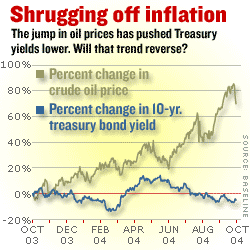NEW YORK (CNN/Money) -
Concerns about oil prices, the election and the economic recovery have been nectar to the busy bees in the Treasury market in recent months, but that trend may be over.
The yield on the 10-year note, which hovered below 4 percent late last month, jumped to 4.17 percent Friday as Treasury investors sold bonds, pushing yields sharply higher, after Friday's October payrolls report came in well above even the highest forecasts on Wall Street.
"There's no question we're in a new range [for yields,]" Christopher Low, chief economist with FTN Financial, said Friday. "This redefines the landscape" for the Federal Reserve.
The recent steep drop in oil prices and the outcome of the election have also spurred Treasury selling, as bond investors now are clearly betting interest rates will start to move up more quickly.
Also contributing to the jump in yields: the sliding dollar, which fell to an all-time low versus the euro Friday. A weaker dollar may point to higher inflation as the purchasing power of the currency declines.
What happens in the Treasury market is important not just for bond investors. It affects the stock market and has a big impact on the economy, since Treasury yields affect many lending rates, including home mortgages.
How far will the Fed go?
The last time investors got a whiff of inflation was in early April, when the government reported the first of two monthly payroll reports showing job growth above 300,000. The news sent Treasury yields soaring to about 4.5 percent from 3.75 percent over the space of just a few weeks.
Friday's payroll report showing U.S. companies added 337,000 jobs in October, with upward revisions to payrolls in August and September, harkened back to those strong job reports last spring.
"The job market was lousy, now it's been upgraded to good," said FTN's Low.
But Treasury yields didn't hold their spring gains and gradually returned to the 4 percent level as the economy hit a soft patch over the summer.
John Lonski, senior economist at Moody's Investor Service, believes bond yields will remain around current levels until hiring picks up again.
"The Fed will eventually move to a neutral stance, and I don't think we're there yet," Lonski said late last month, before the October job numbers were released. "When we start to see payrolls of 200,000 a month, I expect the yield on the 10-year note will hit 4.5 percent and the Fed will become less patient."

Policy-makers at the Fed, which has been raising short-term rates from super-low levels, meet again next week and in December and may feel they have more room to raise short-term rates, though December rate hikes are less common, according to FTN's Low.
But the chances for a December hike rose dramatically after Friday's jobs report, at least according to bets traders make on what the Fed will do at upcoming meetings.
Traders now believe there's an 82 percent chance the Fed will lift rates next month, up from 58 percent before the report, according to Anthony Crescenzi, bond market strategist, Miller, Tabak & Co., citing information from the fed funds futures market at the Chicago Board of Trade.
In addition, Crescenzi said Friday traders were betting there's a 60 percent chance the central bank raises rates at its two-day meeting in February, up from 20 percent before the jobs report.
Fed policy-makers started raising short-term rates in June to where they stand now, at 1.75 percent, after cutting them aggressively the prior three years.
Another thing the Fed will be watching is China, which took its boldest step yet to try to cool its red-hot economy by recently lifting interest rates for the first time in nine years. If China's torrid economic growth continues, it may drive inflation higher worldwide, which could give the Fed another reason to raise rates more aggressively.
Election tension
While uncertainty about the election had sent investors for the perceived safety of Treasury bonds, that also set the stage for a quick reversal after the election was over.
Indeed, stocks rose and Treasury prices slumped after the outcome became apparent Wednesday.
If there had been a long legal fight about who won the Oval Office, it may have driven money out of stocks and out of the country, said FTN's Low. "In a major crisis, like after 9/11, people take the flight to safety further and put some money into Europe," he said.
How low for oil?
After making its way through the summer soft patch, the economy may be set to accelerate as oil prices have dropped more than 12 percent over the last week and oil has been a big influence on the bond market, said Matthew Martin, senior economist at Economy.com.
While the rebound from the soft patch has been about what Fed policy-makers have expected, Martin said, "what they're really looking at now is oil prices."
Traditionally, high oil prices have spooked bond investors, who are hypersensitive to anything that erodes their returns.
But this year, rather than worrying about inflation, bond investors were betting that high oil prices will act as a drag on economic growth, which would tend to keep interest rates low. Thus, bonds had been rallying despite rising oil prices. But now that trend finally seems to be reversing.

-- This is an update of a story that was originally published Oct. 28.
|

